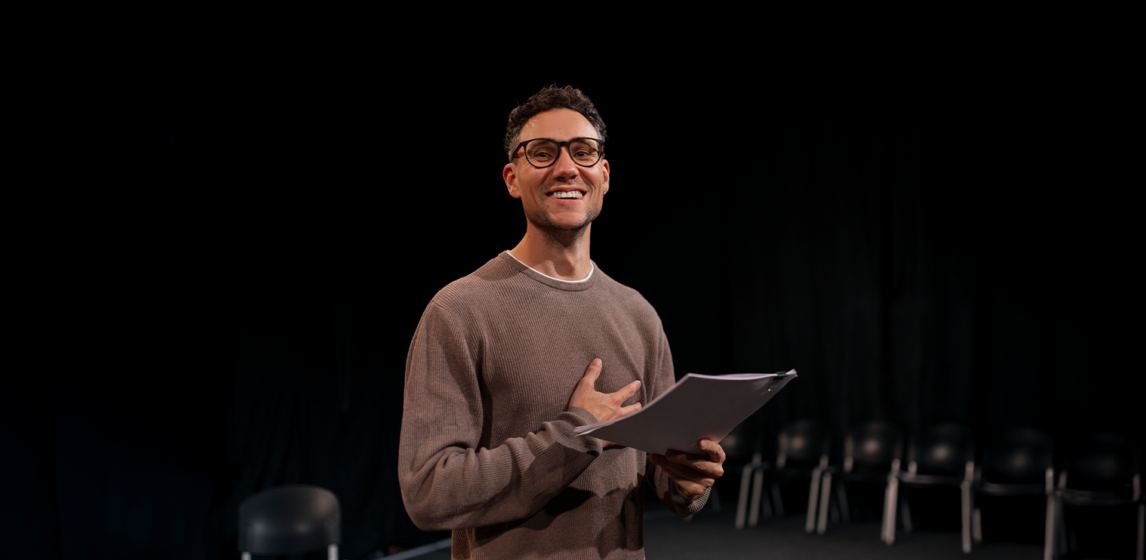Jon had been in the hospital for over a month by the time I sat down with him. We didn't know each other, but I stopped by to check in. As I sat down, he played with the plastic lanyard he was making. He refused to make eye contact, and clearly didn't want to talk.
Yet I could tell he was struggling. So I pulled up a chair close to his bed and just sat. Periodically I would ask a question about the things around his hospital room. And I made a few comments about how hard it must be to be in the hospital. But mostly, I sat in calm silence as Jon worked on his lanyard.
After almost twenty minutes, he started talking and crying as he shared his story. Jon had had major surgery a few weeks before and was beginning the long rehabilitation process. He was alone, overwhelmed, and in pain, as he was quickly being weaned off his painkillers. I sat with Jon a long time as he shared his story of pain, struggle, and hopelessness.
Part one of the article The Tools You Need to Help Struggling Teens suggests approaching struggling teenagers like lifeguards approach struggling swimmers. Youth pastors and caring adults should neither head right towards the student, attempting to fix the problem with advice and instruction, nor can they simply standby, even if the situation seems overwhelming. Instead caring adults should engage struggling young people by moving towards them, acknowledging the pain, resisting an agenda, and providing a comforting presence.
But what happens when the student starts talking? The following are some practices all adults can learn to adopt when talking with struggling teens.
Mirror
One of the best ways to make an adolescent comfortable when sharing their struggles is to practice mirroring. When faced with someone who is struggling, we often try to counteract their mood to mitigate the situation. You can see this most often in sad situations, when someone inevitably makes a witty comment or joke to lighten the mood.
But instead of counteracting their mood, mirror it. Mirroring is the practice of reflecting the emotions, body language, tone, and affect of the other. If they are sad, frustrated, angry, or apathetic, match that. Watch their posture, facial expressions, language, volume, and gesturing and reflect that back. Mirroring lets the adolescent know it is safe to share their reactions and emotions, and shows you understand what they are going through.
There is one time mirroring does not work: when a student is in crisis. When entering into a situation where a student is panicking or overreacting, be empathetic in your disposition, but calm them down by being a non-anxious presence. Do not react to their panic with panic. Stay calm and steady. Help calm them down by having them sit down, drink some water, and take deep breaths.
Listen Empathetically
It’s difficult to listen empathetically without sharing our own opinion or relating our own experiences. We often want to jump in with a story or advice that relates to us. But when a teenager is dealing with pain, loss, or stress, they need someone there to listen to them and understand from their perspective.
Empathetic listening means not just giving the adolescent a chance to talk, but really trying to give them space to share and explore their own thoughts and feelings. And it means listening with the heart, not the head. More important than analyzing the situation or getting the facts straight, listen for feeling words and expressive body language.
Try to pick up on the specific emotions they are sharing. Are they feeling neglected or more ostracized? Is this a blanket anger or specific frustration? Is this resentment or shame? Use your own similar experiences and feelings to inform your perception of what is going on. Your stories and experiences may help you empathize. Show them you understand by the way you respond to them, not by sharing your own similar story, in order to keep the focus on them.
Avoid Questions and Embrace Silence
To help an adolescent explore how they are reacting to pain and struggle, we need to give them space and follow their thoughts and feelings. Questions can help, but they can also hinder the process. Specific questions guide a conversation, making it difficult to explore the full experience of the adolescent. For instance, they may not share something that’s really worrying them because the questions have been focused on other topics. Also, asking too many questions can lead to a cycle of short answers that go nowhere.
Instead, use questions sparingly to encourage a teen to share or to clarify their struggles. Use brief, open-ended questions that explore their worries and allow them to share their perspective. “What was that like?” “How does that make you feel?” “What do you think about that?”
Sometimes, instead of using questions to keep the conversation going, embrace silence. Attentive silence gives adolescents time to think about whatever is churning inside, and decide what they do or do not want to share. It also gives them a chance for both you and the student to be attentive to what you’re experiencing while talking together. It can take time for the student to decide what to share and how. Resist the need to fill up the empty space with words or actions, and embrace it as a chance to create a safe place for the adolescent to just be.
Reflect
Perhaps the most difficult, but most effective, skill we can use when helping a struggling kid is reflecting. Reflecting is the practice of restating the words or feelings the adolescent shares back to you. This demonstrates that you understand and accept what they are saying. Reflecting can include paraphrasing, reflecting feelings, and reflecting cause. [[For more on reflective listening, also called “active listening”, see the chapter “The Heart of Helping” in Helping the Struggling Adolescent by Les Parrott III and the chapter “Deep Listening” in The Youth Worker's Guide to Helping Teenagers in Crisis by Rich Van Pelt and Jim Hancock]]
- Paraphrasing means listening to the student and summing up what they have said in their own words.
Teen: “I just get so nervous sometimes, like I’m not going to be accepted anymore once they know what I’ve done, you know? I’m so scared.”
Adult: “Yeah, you’re worried they won’t accept you again.” When paraphrasing, listen to the content of what they are saying and repeat it back concisely.
- Reflecting feelings means mirroring back the emotions they are communicating, either in their words or body language. Listen for feeling words and use empathy to reflect back their emotions.
Teen: “I just… it’s just so unfair, you know? I’ve tried and tried and I can’t get anywhere with them. I called yesterday. I tried again this morning. It sucks. Ugh!”
Adult: “It sounds really frustrating.” Pick up on the emotions and feelings of the student as they share, and state it concisely. “This is really…” “It sounds like…” “Wow, must be…” Put yourself in their shoes and ask what you’d be feeling going through what they are going through.
- Reflecting cause means reflecting back the situation and the feelings it provokes together. When reflecting cause, we state the cause and effect, the way certain situations have led to certain feelings.
Teen: “I just feel so terrible. Because I really wanted to do well, and do the right thing, and then I chose to do this instead. So stupid. I just don’t know what I’m going to do, or how to fix it.”
Adult: “You feel overwhelmed because you feel guilty and you want to do the right thing now, but you can’t figure it out.” There are lots of ways to reflect the cause (the situation) and effect (the feelings), but using the phrase, “You feel… because…” is a good place to start.
These three skills can help throughout the conversation, allowing the student to share in a setting that makes them feel safe, accepted, and understood.
As you listen for a while, pay attention to the overall theme, along with the feelings, words, and situations the teenager keeps circling back to. You can then reflect back a summary of what you’ve heard. “It sounds like a lot of what you’ve been feeling through all of this is….” “It sounds like all of this revolves around….” “I know you’ve been talking about… but it seems like… is really what you’re worried about.”
The student may not be able to recognize their core concerns or their emotions on their own, and reflecting back a summary can help them gain clarity and understanding about their own situation and how they are reacting to it.
Know When to Get Additional Help
Using the practices of mirroring, reflecting, and listening empathetically creates a safe place for teens to unpack their struggles in the presence of a compassionate adult. It is difficult to watch teens we care about experience the pain of their situation. But working through pain, loss, grief and struggle is a process.
As caring adults, we act as shepherds, creating a safe place for adolescents to move through their pain without short-circuiting the process, patiently unpacking their pain with them and praying for God’s healing to come. [[For instance, Elizabeth Kubler-Ross outlines the now-famous stages of grief associated with loss (denial and isolation, anger, bargaining, depression, and acceptance) in her book “On Death and Dying,” Scribner,1997. This does not only apply to death, but also to parents’ divorce, moving, changing schools and graduating, the failure to achieve a dream, a breakup or loss of a friendship, a change in role, or even the loss of a prized possession, like a cell phone. Adults help teens most when allowing them to experience these stages of grief in a caring environment, journeying with them toward acceptance in their own time. For additional suggestions from FYI, especially on helping adolescents through grief and loss, see “Good Grief” by Kimberly Williams.]] Adolescents are resilient, and most teens will naturally move out of their grief and sadness on their own. [["The great surprise of resilience research is the ordinariness of the phenomena. Resilience appears to be a common phenomenon that results in most cases from the operation of basic human adaptational systems.” Ann S. Masten, “Ordinary Magic: Resilience Processes in Development,” American Psychologist vol. 56, no. 3, March 2001) 227. See Fuller Youth Institute’s articles “Resilience: A Closer Look” by Jesse Oakes and “Bouncing Back” by Maria Drews.]] But we also watch for opportunities to invite in professionals to move through their pain with them, too. When a student is experiencing serious grief or depression, seek additional help from professionals. And when in doubt, another adult, especially a trained psychologist or grief counselor, can offer the specialized help necessary to move the adolescent through the process in a healthy way. Sometimes our greatest tool when working with struggling teens is our ability to quickly connect them with outside resources.
When talking to struggling teenagers, we trust that God is there with them through the pain. As Christians, we know that God may not always take away our struggles or immediately rescue us from crisis. But moving toward the struggling adolescent, listening and reflecting, providing a compassionate presence, and journeying with them are all ways we incarnate God’s presence with them. We demonstrate God’s steadfast love and presence through our own compassionate presence.
There is a time for instruction and advice, for holding teens accountable to take action and motivating them to deal with their struggles head-on. But when they are in pain and loss, struggling with stress or anxiety, we have to start by walking with them as Jesus walks with us all. I know that’s certainly what Jon needed.
Amazon Affiliate links are included in this blog post. FYI earns from qualifying orders placed through links in this post.
More From Us



Sign up for our email today and choose from one of our popular free downloads sent straight to your inbox. Plus, you’ll be the first to know about our sales, offers, and new releases.


